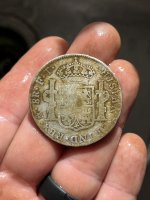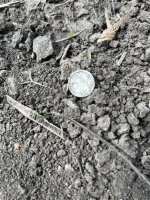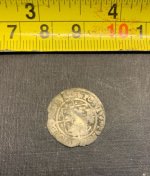Gypsy Heart
Gold Member
Dr. Schuchardt's Buried Earthen Jars of Gold and Silver
Martins Ferry is a city in Belmont County, Ohio, United States, on the Ohio River
From: Wheeling News Register - 1949
MARTINS FERRY – A monument
stands overlooking the river on Wilson
Street in the north end of Martins Ferry.
The monument, about 20 feet high and
made of solid granite, is all that remains
to tell a story of love and murder and
hidden gold that kept citizens of the Ohio
valley on edge for months.
The inscription on the stone says
merely, “In Memory of Wilhelmine,
Wife of Dr. G. Schuchardt, Born August
11, 1811, Died June 16, 1882.” But the
story of three of the six people buried
beneath the ton of stone, still lies in the
dusty files of the old Wheeling
newspapers.
The old Wheeling Intelligencer
was a much different paper in 1883 than
it is today. Back then it was a four-page
daily, with the news, always a day late
and sometimes older, sandwiched in
between countless advertisements for
cough syrup and liver medicines. There
was no teletype, no transatlantic cable in
1883. But the frock-coated, button-shoed
citizens of Wheeling were shocked on
March 20, 1883, to read of the tragic
death of Dr. G. Schuchardt.
They read, between a story of a new smallpox epidemic and an announcement of
a sale of blooded horses in Bellaire, of how the old doctor had received an irate young
visitor about supper time on the evening of March 19, of how he had taken the young
man into the kitchen of his combined home and drug store on Main street, between
Twenty-first street and the old paper mill alley, and of how workers in the store heard
two pistol shots ring out and ran to the kitchen, to find the old doctor dying with a bullet
in his temple and the young man in serious condition with a wound in his head.
His Loved One Wronged
The young man recovered, however, and was identified as Guenther Schnelle,
nephew of the murdered man. Yes, he said, he had killed Dr. Schuchardt and tried to kill
A neighbor points out the inscription on the
Schuchardt monument.
himself. The dead man had done one he loved a terrible wrong, and he was not sorry for
what he had done.
Young Guenther Schnelle was held in prison to await trial for his crime.
Meanwhile Dr. Schuchardt was buried next to his wife, Wilhelmine, who had died the
year before, in a plot of ground on his farm overlooking the river outside Martins Ferry.
Hardly had the old doctor been buried until the case took another turn. On March 26, four
days after the funeral, a man named Wendel Dickescheld, brother-in-law of the deceased,
was apprehended with $7,000 in silver coins which he had taken in 6 bags to a Wheeling
bank for safekeeping. He said the old man had dug it up from great earthen jars buried in
the cellar of his home and had given it to him two days before his death.
The whole district was set abuzz, of course. Was it true that old Dr. Schuchardt
was a millionaire? That he had a hidden treasure? Was he murdered for his money? And
most important, was there any more money in the cellar? Relatives, lawyers, police, all
turned the cellar upside down, but no “great earthen jars” could be found.
Interest in the murder lagged after that, to be awakened suddenly on May 31 when
police found Mrs. Mary Bach, grandmother of the murderer’s brother, dead in the same
house. She was found hanging from the top of a door by a towel in the same room in
which Dr. Schuchardt and Schnelle had staged the earlier tragedy. No connection
between the two incidents could be uncovered.
On October 5, 1883, Guenther Schnelle was sentenced to life imprisonment for
the murder of Dr. Schuchardt. The murderer’s brother had spent all his influence and
resources to keep Guenther from hanging, and he had won.
Gold Discovered
So ends the story of the Schuchardt tragedy and its accompanying entanglements.
Well, almost. Years later, the Wheeling Stamping works was tearing down the old
Schuchardt house to make room for their new plant. A laborer from Bellaire was digging
in what had been the old cellar, preparing the ground for a foundation. His shovel struck
something hard. Before he was through, the man had unearthed four great earthen jars
filled, not with silver, but with gold. Dr. Schuchardt’s heirs contested the laborer’s right
to the treasure, but the courts ruled against them.
Only the monument now remains to recall this story and these people. Dr.
Schuchardt and his wife and the old grandmother, Mrs. Bach, are all buried beneath the
stone on Wilson street that overlooks the river. Guenther Schnelle died in prison, and of
Dickescheld, the man who first found the buried money, noting further was ever heard.
The little cemetery plot is owned now by Hugh Myers, who lives across the street
from the monument. He purchased the ground in March 1938; just 55 years after the
murder took place, because he wanted a clear view of the river. This makes him one of
the few private citizens in the country to own a cemetery, but where the Schuchardt
history is concerned, unusual things are rather to be expected.
Note: 1997 – A neighbor who lives near the plot reported that the monument had been
destroyed some years earlier.
Martins Ferry is a city in Belmont County, Ohio, United States, on the Ohio River
From: Wheeling News Register - 1949
MARTINS FERRY – A monument
stands overlooking the river on Wilson
Street in the north end of Martins Ferry.
The monument, about 20 feet high and
made of solid granite, is all that remains
to tell a story of love and murder and
hidden gold that kept citizens of the Ohio
valley on edge for months.
The inscription on the stone says
merely, “In Memory of Wilhelmine,
Wife of Dr. G. Schuchardt, Born August
11, 1811, Died June 16, 1882.” But the
story of three of the six people buried
beneath the ton of stone, still lies in the
dusty files of the old Wheeling
newspapers.
The old Wheeling Intelligencer
was a much different paper in 1883 than
it is today. Back then it was a four-page
daily, with the news, always a day late
and sometimes older, sandwiched in
between countless advertisements for
cough syrup and liver medicines. There
was no teletype, no transatlantic cable in
1883. But the frock-coated, button-shoed
citizens of Wheeling were shocked on
March 20, 1883, to read of the tragic
death of Dr. G. Schuchardt.
They read, between a story of a new smallpox epidemic and an announcement of
a sale of blooded horses in Bellaire, of how the old doctor had received an irate young
visitor about supper time on the evening of March 19, of how he had taken the young
man into the kitchen of his combined home and drug store on Main street, between
Twenty-first street and the old paper mill alley, and of how workers in the store heard
two pistol shots ring out and ran to the kitchen, to find the old doctor dying with a bullet
in his temple and the young man in serious condition with a wound in his head.
His Loved One Wronged
The young man recovered, however, and was identified as Guenther Schnelle,
nephew of the murdered man. Yes, he said, he had killed Dr. Schuchardt and tried to kill
A neighbor points out the inscription on the
Schuchardt monument.
himself. The dead man had done one he loved a terrible wrong, and he was not sorry for
what he had done.
Young Guenther Schnelle was held in prison to await trial for his crime.
Meanwhile Dr. Schuchardt was buried next to his wife, Wilhelmine, who had died the
year before, in a plot of ground on his farm overlooking the river outside Martins Ferry.
Hardly had the old doctor been buried until the case took another turn. On March 26, four
days after the funeral, a man named Wendel Dickescheld, brother-in-law of the deceased,
was apprehended with $7,000 in silver coins which he had taken in 6 bags to a Wheeling
bank for safekeeping. He said the old man had dug it up from great earthen jars buried in
the cellar of his home and had given it to him two days before his death.
The whole district was set abuzz, of course. Was it true that old Dr. Schuchardt
was a millionaire? That he had a hidden treasure? Was he murdered for his money? And
most important, was there any more money in the cellar? Relatives, lawyers, police, all
turned the cellar upside down, but no “great earthen jars” could be found.
Interest in the murder lagged after that, to be awakened suddenly on May 31 when
police found Mrs. Mary Bach, grandmother of the murderer’s brother, dead in the same
house. She was found hanging from the top of a door by a towel in the same room in
which Dr. Schuchardt and Schnelle had staged the earlier tragedy. No connection
between the two incidents could be uncovered.
On October 5, 1883, Guenther Schnelle was sentenced to life imprisonment for
the murder of Dr. Schuchardt. The murderer’s brother had spent all his influence and
resources to keep Guenther from hanging, and he had won.
Gold Discovered
So ends the story of the Schuchardt tragedy and its accompanying entanglements.
Well, almost. Years later, the Wheeling Stamping works was tearing down the old
Schuchardt house to make room for their new plant. A laborer from Bellaire was digging
in what had been the old cellar, preparing the ground for a foundation. His shovel struck
something hard. Before he was through, the man had unearthed four great earthen jars
filled, not with silver, but with gold. Dr. Schuchardt’s heirs contested the laborer’s right
to the treasure, but the courts ruled against them.
Only the monument now remains to recall this story and these people. Dr.
Schuchardt and his wife and the old grandmother, Mrs. Bach, are all buried beneath the
stone on Wilson street that overlooks the river. Guenther Schnelle died in prison, and of
Dickescheld, the man who first found the buried money, noting further was ever heard.
The little cemetery plot is owned now by Hugh Myers, who lives across the street
from the monument. He purchased the ground in March 1938; just 55 years after the
murder took place, because he wanted a clear view of the river. This makes him one of
the few private citizens in the country to own a cemetery, but where the Schuchardt
history is concerned, unusual things are rather to be expected.
Note: 1997 – A neighbor who lives near the plot reported that the monument had been
destroyed some years earlier.





